The Big Framework for Growth is a proprietary framework that we use with our clients to map the changes occurring in their categories. It helps them to understand where the opportunities and growth areas are but also flags future risks and dangers to their businesses.
It helps brands and businesses to:
- Minimise risk whilst maximising reward
- Understand and influence the future of categories
- Profit from any category or future change by linking current and future behaviour with commercial
- Manage business and brand transition from today to the future
The framework is based on the intersection between two axis that drive consumer choice:
- Motivations – the desires consumers have to do or achieve something
- Solutions – the products services and experiences available to fulfil those motivations
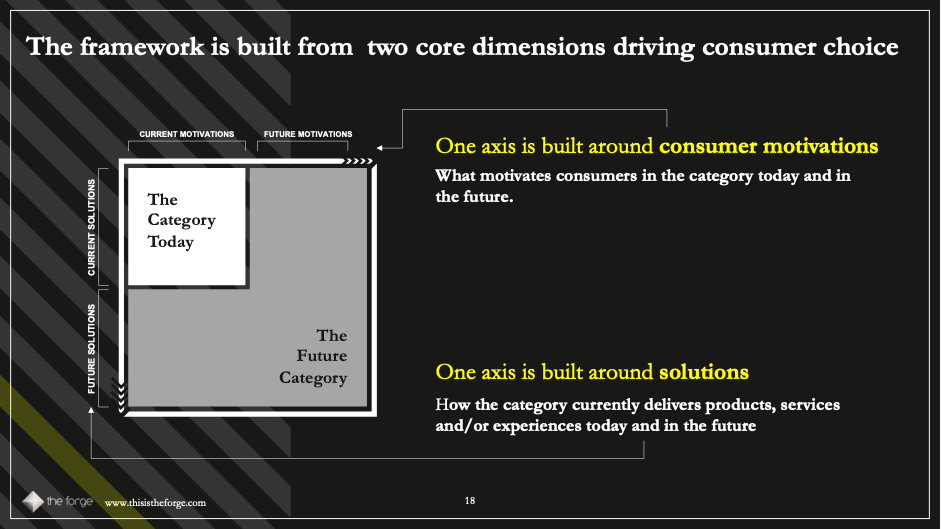
Let’s take the Solutions axis first and look at how Hair Management as a category has evolved over the past decade. The category started out in shampoo, conditioner and styling products as well as devices including hair straighteners and hairdryers. But over the years it has evolved to include specialist home treatments, styling apps, and new devices including steam straighteners or the Dyson wand.
Whilst the motivation for a consumer using any of these products might be the same “to manage my hair”, the solutions available to them have evolved over time creating opportunities and threats to the existing brands in the space.
On the Motivations axis, let’s look at yoghurts. Initially, the motivation for using the yoghurt category was as a post-meal sweet treat. But it has evolved to include desserts that deliver indulgence, probiotic yoghurts for gut health, light products for dieting, fortified and protein-enriched for nutrition, and the addition of grains for sustenance.
Here, the solution has remained largely the same – a thick and creamy liquid in a plastic pot with a foil lid – but by meeting new motivations for using the category, the category has been able to grow.
As you would expect to see on a model created by any self-respecting consultant, the two axes neatly break down into 4 quadrants. Before we go into them, it is important to note two things:
Firstly, whilst quadrants on the framework are clearly delineated, in actuality the distinction between current and future motivations or current and future solutions is a greyer area. Emergent current motivations may grow into much bigger drivers in the future. And solutions that will be widely adopted in the future may already exist now, but just not in widespread use.
Secondly, it is important to bear in mind that solutions evolve much more quickly than motivations. Often the motivations for using a category can remain one-dimensional for many years before exploding into life very quickly. So, we encourage practitioners to look at adjacent categories to get an idea as to where their category could be heading.
Taking each quadrant in turn, let’s start with top left.
1. Current solutions and current motivations: “Improve current category delivery”.
This is where we identify opportunities to better deliver against the current category dynamics by leveraging improved solutions or targeting priority/valuable motivations. Good examples of brands that have done this well include:
Fever Tree – seized upon the growing motivation for increased provenance, flavour sophistication and premiumisation in gin, and brought enhanced quality and botanicals to a previously moribund category.
Monzo – free from the constraints of legacy tech infrastructure and the overheads of fixed-premise branches, Monzo reimagined digital banking with a fun and responsive user experience and excellent customer service.
Heineken 0.0 – the motivation to have a non-alcoholic beer has been around for time immemorial, but Heineken were the first brand to bring a solution to market that delivered on taste.
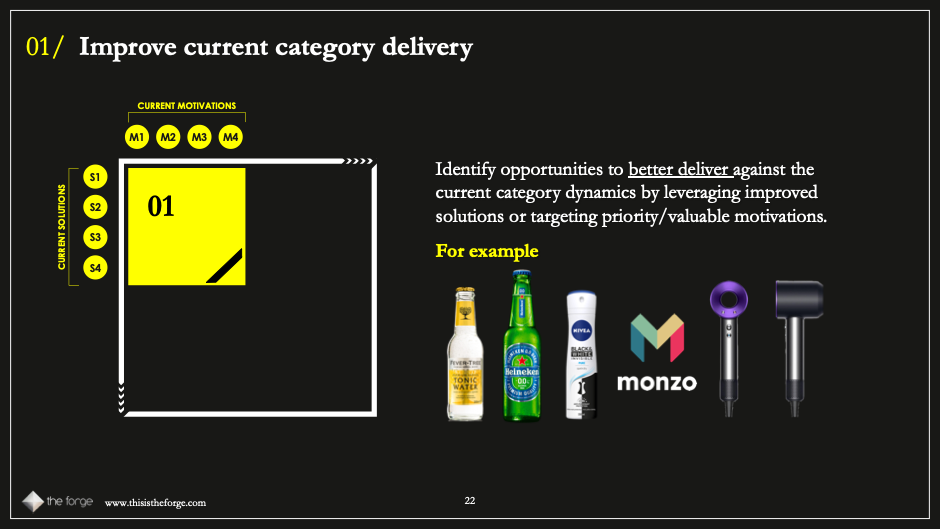
2. Current motivations and future solutions: “Create new types of solutions”
Where we collide existing motivations with new and improved solutions. You will often find that the brands here will be new brands in the category, for example:
Laundrapp – anyone whose motivation was to have their clothes cleaned by somebody else, in a timely and convenient manner, was gifted a new, improved solution in Laundrapp, who pick up, clean, and deliver your laundry back to you – saving you a trip down the laundrette.
Purplebricks – online-only estate agent who advertise your property for you, all you have to do is show potential buyers around yourself – all for a much-reduced fee vis-a-vis high street agents. The motivation, to sell your home remains the same, albeit with an innovative solution to save money.
Zendium – natural, antibacterial toothpaste which works with your microbiome to protect your mouth. Same motivation: oral health – but a new way to meet the need.
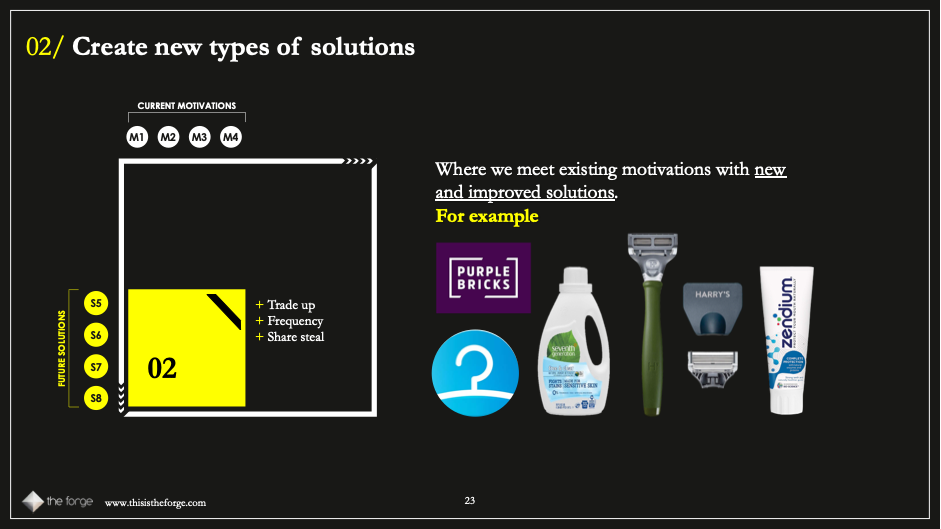
3. Current solutions and future motivations: “Drive new motivations”
It is in this quadrant where we deliver to new motivations in order to evolve what a category can do for people e.g.:
Rapha – in a cycling clothing category previously dominated by the motivation for performance, Rapha’s fancy kit enables wealthy, middle-aged men to look good and perform on their road bikes.
Dettol Laundry – the motivation for antibacterial cleaning products is well established, Dettol merely extended their range into laundry care, encouraging the motivation in a new category.
McDonald’s – launched a salad range for those looking for a fast and healthy option. The solution, fast-food, remains the same. But the motivation it satisfies – health – provides a new product line.
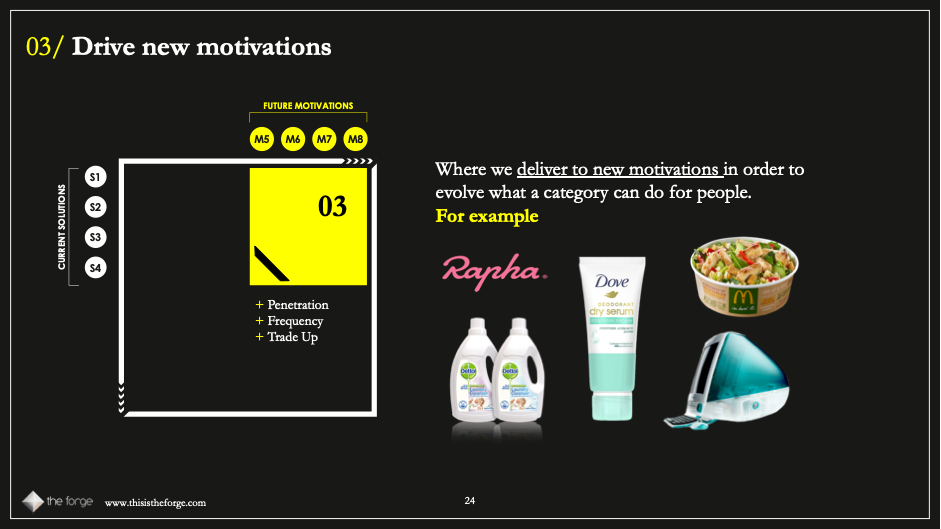
4. Future solutions and future motivations: “Change the rules”
This is where we step change how a category operates, where new motivations are combined with solutions. Good examples here include:
Seedlip – a new motivation – to have an alcohol-free drink but with complex flavour profiles and low in sugar – collides with a new solution – a non-alcoholic ‘spirit’ to be mixed with tonic.
Nike+ – the emerging need for tracking and coaching is met through new technology: an app which can be downloaded onto a smartwatch or phone and integrates with RFID chips in Nike+ running shoes.
Tesla – not only did the cars change the rules by offering performance and eco-benefits, but the end-to-end customer experience delivered in-house by Tesla, without dealerships, has enabled them to build deep relationships with their customers.

A summary of the four quadrants.
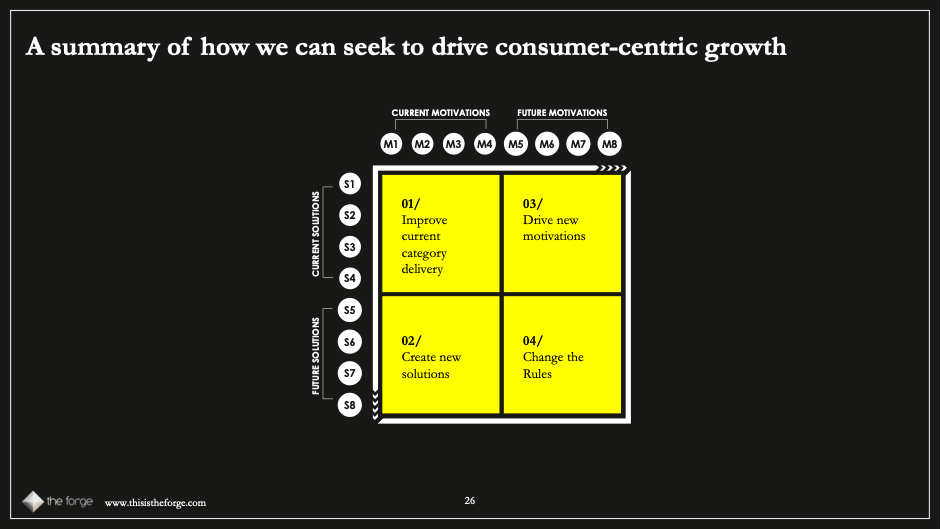
It’s important to say here that all four of these quadrants can be routes to significant growth. Almost any category will have opportunities for improvement in the top left box. And it is often extraordinarily difficult to effectively change the rules in your category as in box 4. Where you focus should be driven entirely by the objectives and capabilities of your business or brand.
We’ll finish up by discussing how you can create your own BFG and how you can use it as a commercial tool to size the risks and opportunities that it uncovers.
A range of inputs can be used to populate each dimension. Firstly for solutions, look for usage and trend-led sources from inside and outside of the category including:
- Usage statistics
- Ethnographic approaches
- Market trawls
- Trends
- R&D roadmaps
- Innovation centers
- Supplier networks
- Technology & emergent IP
One of the best places to get this insight is by asking your suppliers. They will be only too happy to share the trends they are seeing, how they think the industry is evolving and what tech is coming down the line.
For current, emerging and future motivations, look for desk, qualitative and quantitative inputs including:
- Rapid rewinds
- Online communities
- Social media analytics
- Analysis of existing data sets
- Bespoke quant surveys
- Data modelling
- Qual depths/groups
- Segmentations
Depending on what data you have (and how much time and resource you want to invest), the BFG can be constructed as a light-touch tool, with hypotheses generated from existing data and desk research in a workshop with your team. It can also be created as a fully-validated commercial document with sized opportunity spaces, growth trends, and overlaid with brand heartlands and territories.
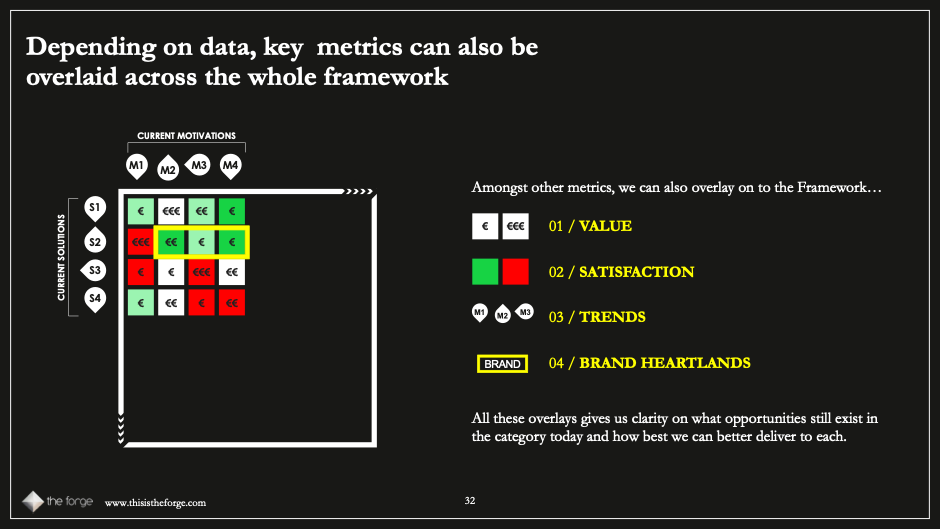
It is important to remember that forecasting the future is not an exact science. So when attempting to do so, we encourage the following:
- Current category size and CAGR should be your start points of your growth assumptions
- Make sensible, evidenced assumptions for predicted customer behaviour and show your working
- Then identify key opportunities
Once an opportunity has been identified you can profile the opportunity and dig into the critical success factors. What are the points of parity needed to enter the consideration set? What are the points of difference needed to win.
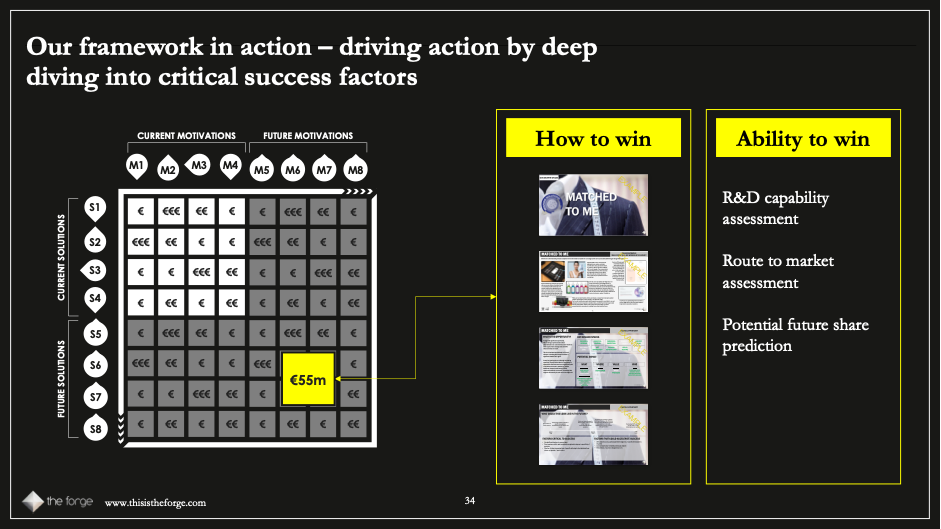
Previous questions we have answered with the BFG include:
J&J – How can mouthwash do more for people?
VF Corp – How can we maximise the potential of new IP?
Zurich – What are the best propositions to drive behaviour change in the UK savings market?
Diageo – How should Diageo respond to the changing values and behaviours of a key segment?
Unilever – Where are the biggest opportunities in the future Beauty and Personal Care category?
Thank you
We hope you have found this a useful introduction to the BFG, please see the links below for further reading and how to get in touch.
If you have any questions about how to create or use the BFG you can check out our instructional video here.
For further reading on how the BFG fits into a wider customer strategy, you can download our whitepaper: How to Create a Winning Customer Strategy here.
Photo by Tomasz Frankowski on Unsplash
